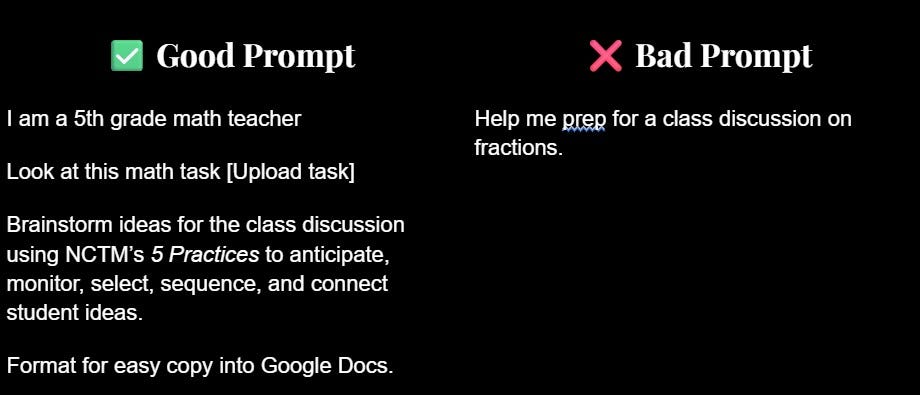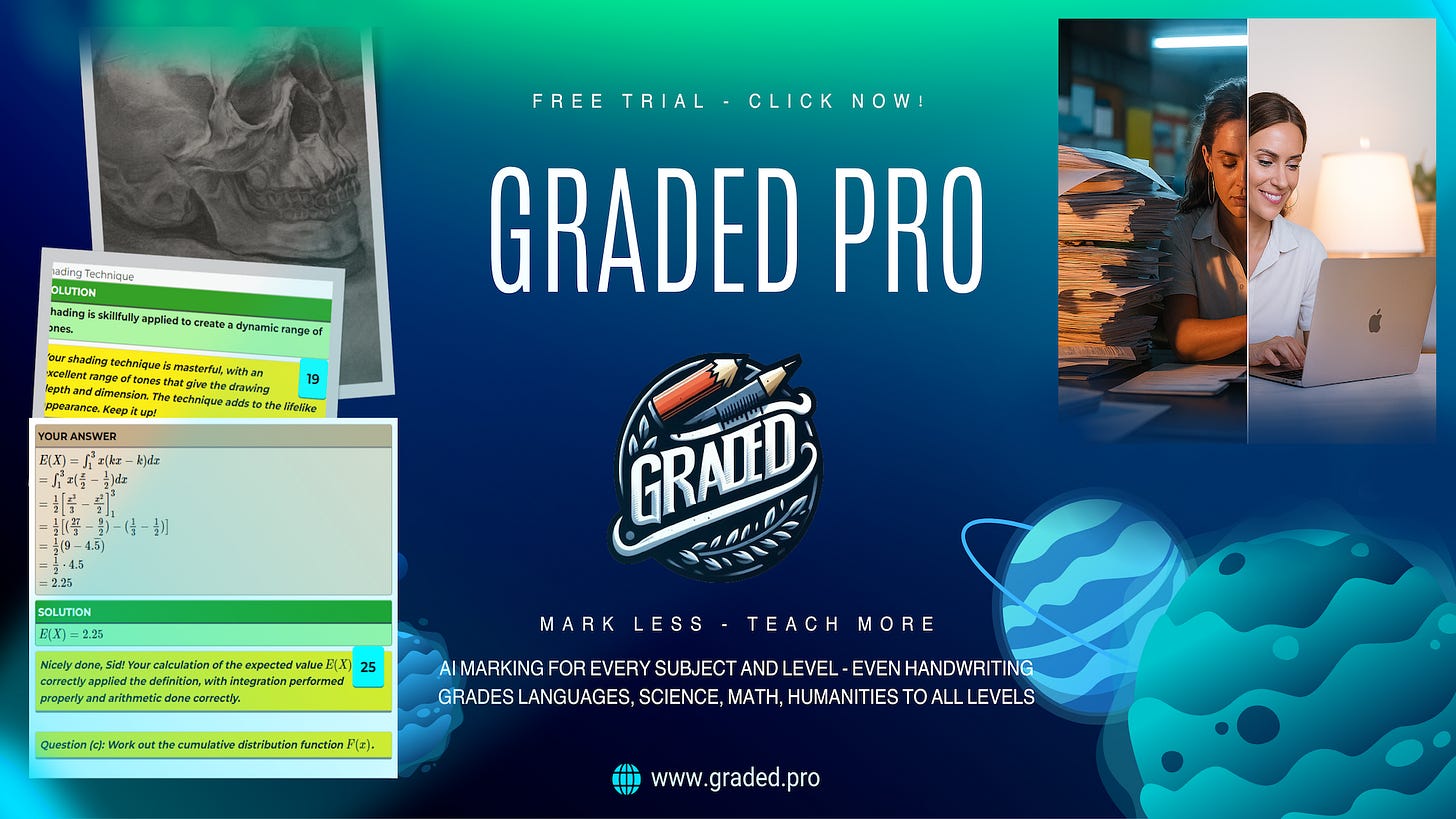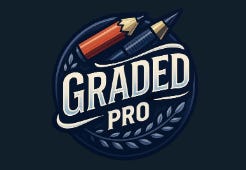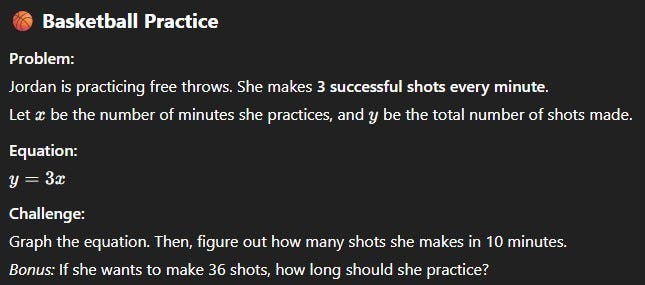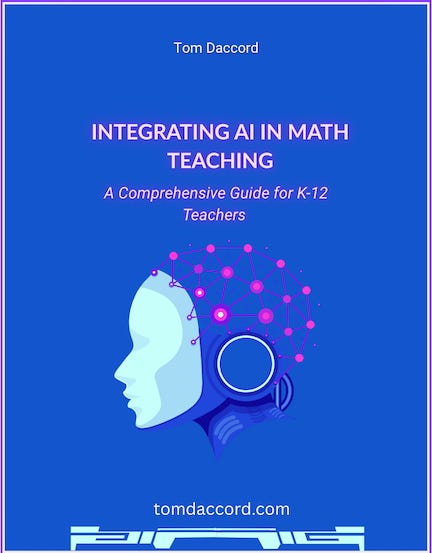Deeper Into Differentiation: How AI Can Help Us Reach All Learners in Math
I am excited to present a guest post by Karen Levin, Math for Humans. Karen is a talented math and edtech instructor who graciously reviewed my Integrating AI in Math Teaching guidebook and provided invaluable feedback. We plan to hold a free webinar on this topic this fall. Details in September!
Every Sunday as a classroom teacher, I faced the same overwhelming truth: my 28 students had 28 different learning needs. I understood differentiation - choice, scaffolds, low floor/high ceiling tasks - but the hours required to implement it daily simply didn't exist. I knew my students deserved more, but I couldn’t outwork the clock.
If this sounds like the math teachers in your building, you're not alone. And there’s finally a solution.
AI tools can transform the weekend burden into manageable weekday tasks.
As Tom noted in his post on scaffolding, this potential here is real. Below I’ll show practical AI differentiation strategies that meet diverse student needs without sacrificing teacher weekends.
How to Write Effective Prompts
A strong prompt for math differentiation has four parts:
Persona – Who you are (e.g., “I am a 5th grade math teacher”).
Aim – What you want AI to do (e.g., brainstorm, adapt, generate problems).
Math Research Frame – The strategy you want it to use (e.g., NCTM’s Principles to Actions, Universal Design for Learning, WIDA Level, etc.).
Format/Structure – How you want the output organized (e.g., table, bullet points, copy-paste ready).
Here is a good and a bad example:
Why Research-Based Prompts Get Better Results
Large language models like ChatGPT are trained on general internet data, so they "know" contradictory things about math teaching. They know good pedagogy involves real contexts, visual representations, and conceptual understanding. But they also know that most math instruction defaults to memorized procedures, tricks, and "just do it this way" explanations.
Without guidance, AI defaults to lower standards and harmful shortcuts.
Strong differentiation prompts solve this by grounding requests in research-based practices. This article uses National Council of Teacher of Mathematics (NCTM) differentiation guidance to direct AI toward proven pedagogy.
NCTM offers over ten differentiation recommendations. Below are three strategies that demonstrate what's possible when AI meets research-based practice. Take what resonates and use AI to differentiate based on the principles that work best for your students and context.
In partnership with Graded Pro
Graded Pro is a robust platform that has evolved from a smart Google Classroom add-on into a full-service AI grading ecosystem now used by over 1,000 schools worldwide.
Graded Pro effortlessly handles essays and extended writing, mathematical proofs, science reports, art portfolios, and even messy pen-and-paper work and sketchbook pages. COPPA, FERPA compliant.
With Graded Pro, teachers can grade work up to 95% faster, freeing hours each week for student coaching and individual support.
Global curriculum frameworks come pre-loaded with U.S. Common Core, AP, IB, UK GCSE, and A-Level. Custom rubrics are just a copy‑and‑paste away.
Strategy 1: Use Open Tasks for Multiple Entry Points
Traditional differentiation often means creating easy and hard versions of problems. While this can be effective, open tasks, inspired by Marian Small and Open Middle, meet the needs of varied students, allow for multiple entry points and spark rich classroom conversations. Let’s see it in action.
*Note: In this article, I’ll use ChatGPT in the examples, but you can substitute your AI of choice (Gemini, Claude, Khanmigo, etc.).
Prompt:
Create an open math problem about fractions that 4th graders can approach at different levels. The problem should have multiple solution strategies and allow for both basic and advanced thinking. Use Marian Small’s theory of differentiating instruction.
What ChatGPT Gives:
Differentiation Technique: Open-ended question with multiple entry points - students can use simple fractions or challenge themselves with complex ones.
What Happens Without the Research Framework: Try the same prompt but remove "Use Marian Small's theory of differentiating instruction."
What you get instead: A closed, step-by-step problem that claims to be differentiated because students "can use pictures or manipulatives." This misses the point entirely.
Why it works: Including research frameworks in prompts produces significantly better results than generic requests. Generic prompts yield traditional worksheet problems disguised as differentiation.Strategy 2: Adapt Language Without Lowering the Math
In many classrooms, students bring different home languages and a varying levels of English proficiency. Adjusting instructions for each can be time-consuming, but the goal is always the same: make the language accessible while keeping the mathematics intact.
Prompt: Reword this math instruction for a multilingual learner at WIDA Level 2: [insert instructions]
What ChatGPT Gives:
Differentiation Technique: Shorter sentences, simpler vocabulary, clearer structure.
Why it works: AI excels at language modifications and translations. However, watch for removed vocabulary words and prompt AI to include them.Strategy 3: Connect Math to Student Interests
Choice gives students autonomy, boosting motivation and engagement. AI makes it easy to adapt the same math concept into contexts that match different student interests.
Prompt: "I'm teaching about graphing linear equations to 8th graders. Three students love sports. Create word problems that connect to this interest."
What ChatGPT Gives:
Follow up:
Give me problems for students who love cooking
Create versions for students interested in social media
Caution: ChatGPT can make up problems that don't make sense. Always complete the problems before giving them to students.
Why it works: When learners engage with a topic they care about, or feel ownership over how they approach a task, whether choosing the challenge level, strategy, tool, or mode of expression, they are more likely to persist and invest effort.These three approaches show how AI can support differentiation needs.
But AI has limits.
When AI Misses the Mark
While AI works well for these three strategies, AI isn't a magic solution for every teaching challenge.
I tried multiple times to create a graphic organizer for comparing linear equations, but every version stripped the thinking from the task. Not every task benefits from AI. Use your judgment to refine or abandon.
Next Level: Custom AI for Differentiation
When standard prompts reach their limits, that's where specialized AI tools become essential. Specialized AI tools like Custom GPTs (ChatGPT Plus) and Gemini Gems (free through Google for Education) trained specifically for math differentiation are transformative. I've developed custom AI that understands both differentiation principles and mathematical pedagogy, trained on research about productive struggle and maintaining cognitive demand.
The difference is striking. Standard AI defaults to lower expectations and teaching tricks. Custom AI maintains rigor, focuses on conceptual understanding, and adjusts support.
Student-facing AI tools are emerging too, but those raise different questions and aren’t the focus here.
For leaders implementing at scale, this eliminates the trial and error cycle that burns out teachers and ensures consistent, research-aligned results across your math team.
A 3-Step Framework for Leaders
Teachers can use these strategies tomorrow. But for leaders, individual experiments aren’t enough. Moving from experimentation to purposeful use requires a clear framework, one that turns “AI overwhelm” into strategic clarity.
Step 1: Start Small
Choose one challenging unit
Try one strategy from above
Test with a pilot group
Step 2: Evaluate
Does this maintain productive struggle?
Are all students engaging in mathematical reasoning?
Are we supporting thinking or replacing it?
Step 3: Scale Strategically
Focus: Use AI where it amplifies expertise and solves a specific problem
Define Success: Work with your team to agree on what “good use” looks like for teachers, students, staff
Grow What Works: Expand strategies that show impact. Drop or adjust what doesn’t.
The Bottom Line: Guidance Makes the Difference
Without clear guidance, AI creates noise and risks removing the thinking from students. With the right guidance, it saves teachers time and deepens student reasoning.
Ready to Transform Your Math Differentiation?
The strategies shared are just the beginning. Don’t let another year go by with AI creating mediocre worksheets. Equip your team with strategies that honor both student complexity and mathematical beauty.
Want to go deeper? Email me at karen.levin.education@gmail.com for access to my Use AI to Differentiate Learning: 19 Prompts That Work. This resource moves beyond basic leveling to support authentic mathematical reasoning for every learner.
For ongoing strategies on math and AI, connect with me on LinkedIn.
The future of math education isn't about AI replacing expertise. It's about AI amplifying your ability to meet every student where they are while challenging them to think deeply about mathematics.
My new, free 90-page guidebook is now available for download at tomdaccord.com
Any suggestions to improve this newsletter? Please message me or leave a comment below!


